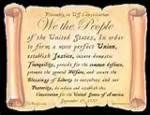“Government has an inborn tendency to grow. And, left to itself, it will grow beyond the control of the people. Only constant complaint by the people will inhibit its growth.”
Ronald Reagan, Address to the Comstock Club, Sacramento, August 6. 1973
Section 8 of Article 1 of the US Constitution assigns certain functions and powers to the Congress. This Section is commonly known as the Enumeration of Powers. Because this Section gives a list of the enumerated powers, I will cover some of the concepts needed to understand how the power structure works in the Congress. You may want to refer back to this post as we look at all the powers on the enumerated list.
Political power, within the concept of federalism, was divided between the two levels of government. The national government was to have limited and enumerated powers. The powers not given to the national government remained with the states as reserved power. Additionally, the national power was divided between the three branches of government with a system of checks and balances in place.
According to Dr. James McClellan in his book, Liberty, Order, and Justice, the powers of Congress can be classified as:
1. Enumerated or delegated – listed. The word delegated means that some of these were powers assigned by the states to the federal government.
2. Implied – expressed indirectly. This is done with the use of the “Necessary and Proper Clause”, which is also in Section 8. I will discuss it in a later post. This clause expands the enumerated powers of Congress. An example would be since Congress has the power to regulate interstate commerce, then it could make a law regulating shipping of materials from one state to another.
3. Prohibited – forbidden by authority
4. Inherited – powers inherited from the British Parliament and earlier state constitutions. (As in Article 1, Section 5, which is modeled after British Parliament with some important changes)
Following along with Dr. McClellan, the powers can be further divided into exclusive and concurrent. Exclusive means belonging only to the Congress (the power to declare war). Concurrent powers are powers shared with the Executive Branch or with the States. (Congress shares with the President the power to make war. It shares income tax power with the States.)
James Madison strongly believed in the importance of reserving as much power as possible to the States and to the people (we the people). Writing as Publius in Federalist 45, he writes:
“The powers delegated by the proposed Constitution to the federal government are few and defined. Those which are to remain in the State governments are numerous and indefinite. The former (federal powers) will be exercised principally on external objects as war, peace, negotiation, and foreign commerce… The powers reserved to the several States will extend to all the objects which, in the ordinary course of affairs, concern the lives, liberties, and properties of the people, and the internal order, improvement, and prosperity of the State.”
Overall, in Article 1, Section 8, we the people empower Congress with certain specified powers so that they can govern effectually.
The benefit to we the people is that we have a Congress strong enough to make decisions and govern, while at the same time limiting the powers of Congress by reserving numerous powers to the States and to the people.
In the next post, I will discuss Article 1, Section 8, beginning with Clause 1 to point out the benefits of the first principles in your life.
God bless you!
References:
Findlay, Bruce Allyn and Findlay, Esther Blair. Your Rugged Constitution. Stanford: Stanford University Press, 1950
Hannaford, Peter. The Quotable Ronald Reagan. Washington, DC: Regnery Press, 1998
McClellan, James. Liberty, Order, and Justice. Indianapolis, Liberty Fund, Inc., 2000
Skousen, W. Cleon. The 5000 Year Leap. National Center for Constitutional Studies, 2006


